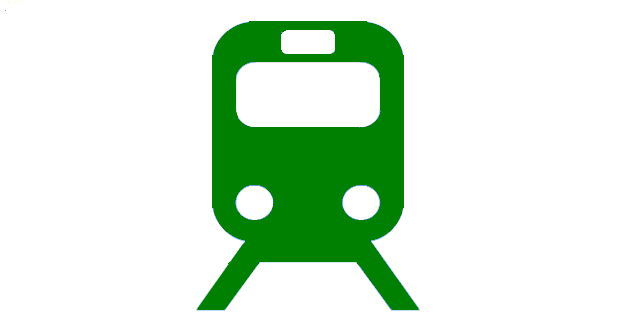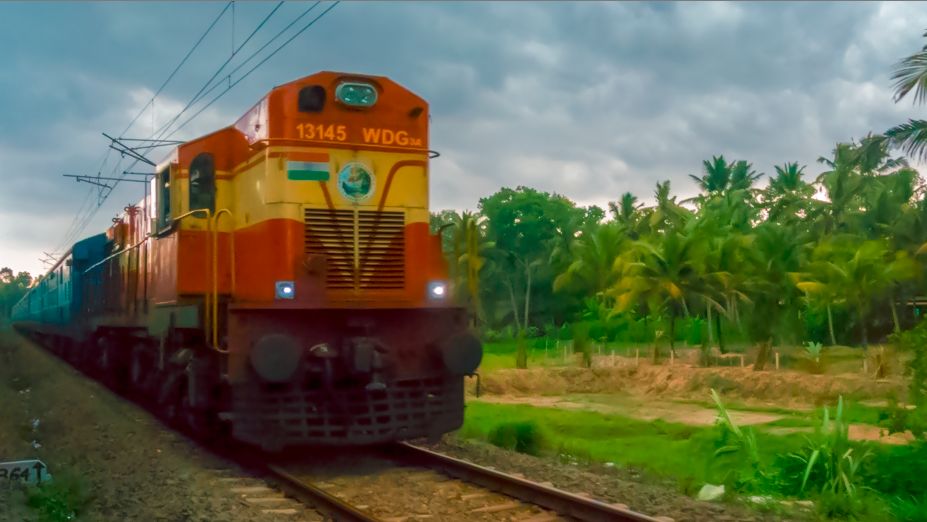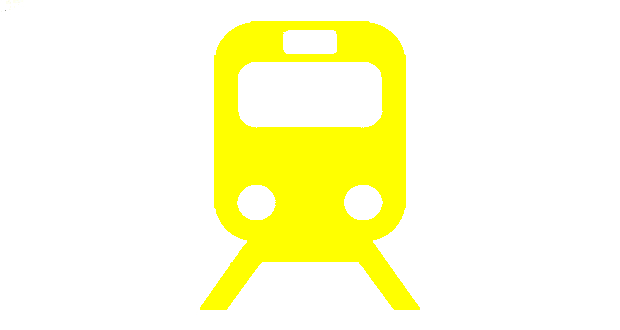The State of the Railways in Kerala: Train Running Operations
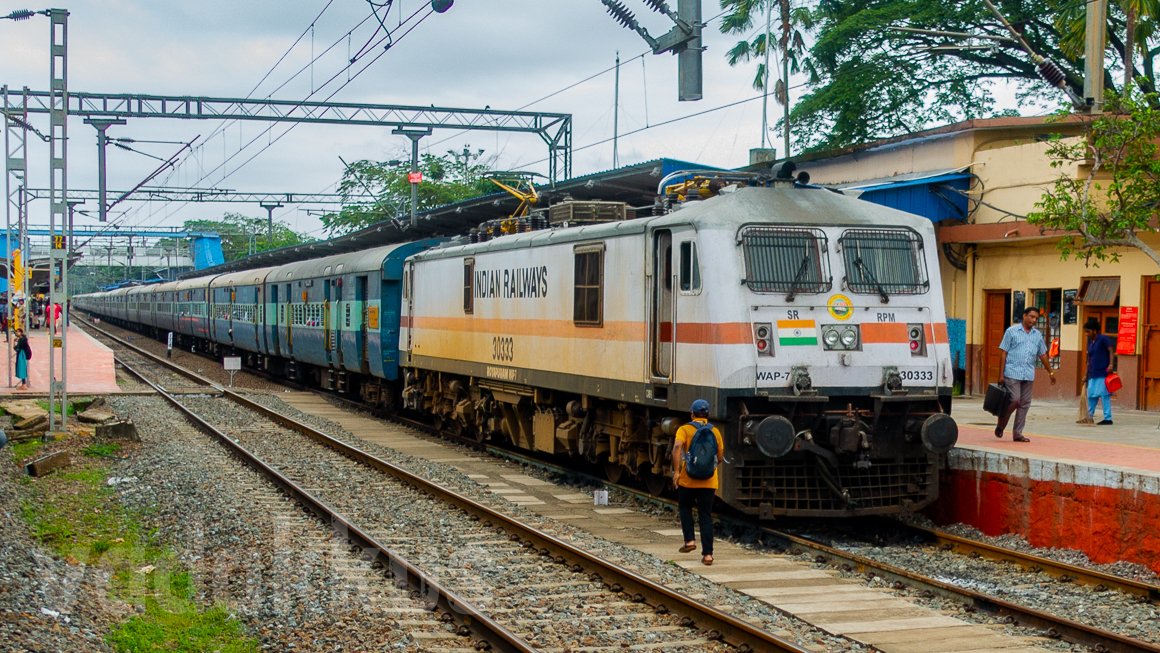
A long, long time ago, during the ancient, underdeveloped times of the year 1977, the 374 Venad Express would depart Trivandrum Central at 0600 every morning, heading north for Ernakulam on the newly converted Broad Gauge line. Powered by a single 2600 hp diesel locomotive, it would cover the 220 kilometres of manually (Semaphore) signalled fully single line to arrive at Ernakulam Jn. at ten, exactly four hours later. Today, 40 years since, the 16302 Venad Express runs on an electrically interlocked, colour-light signalled, 90% double line, powered by a 6350 hp three-phase AC electric locomotive. And in these days of degenerating technologically advanced awesomeness we live in, guess how much time it takes to cover the same 220 km? Five hours and fifteen minutes as per the timetable which regularly goes up to around six hours given the inevitable delays and now among the slowest trains on the route (the fastest one still takes the same four hours the Venad took 40 years ago)! But that is not the entire story, not yet, it gets worse. Thousands of (yes) commuters from the Central Travancore region board the train from its many halts trying to make it Kerala’s commercial capital before office time, only to fail miserably, almost every day. Hardships faced by commuters have repeatedly been highlighted in the media and elsewhere but of no avail. They then “made” it run “on time” by forcefully extending its arrival timings of the train at Ernakulam! But it still arrives late.
These travails of the Venad Express is the best indicator of the rot of the railways in Kerala. Across the world, with passage of time, travel technology is generally expected to improve, shortening distances and improving qualities of life. This has happened in India too, but not everywhere. In a forgotten south western corner of the country, things haven’t only not improved but gotten worse compared to forty years earlier. It is not just Venad, but nearly every single train running in the state has only gotten slower. Let us look at times taken by some trains in Kerala to cover their distances as they did in the years of 1977, 1990, 2001, 2010 and 2019.
| Train | Route | Distance | 1977 | 1990 | 2001 | 2010 | 2019 |
| 12623 | Palakkad-Trivandrum | 367 km | 0400-1200 | 08:00 | 0400-1145 | 07:45 | 0350-1145 | 07:55 | 0340-1125 | 07:45 | 0400-1215 | 08:15 |
| 12625 | Trivandrum-Palakkad | 367 km | 1455-2235 | 07:25 | 0940-1800 | 08:20 | 1110-1905 | 07:50 | 1115-1845 | 07:30 | 1115-1845 |07:30 |
| 16630 | Shoranur-Trivandrum | 325 km | 0130-0930 | 08:00 | 0135-0935 | 08:00 | UA | 0125-0910 | 07:45 | 0110-0930 | 08:20 |
| 12601 | Palakkad-Mangalore | 350 km | UA | 0415-1315 | 08:20 | 0435-1425 | 09:50 | 0450-1225 | 07:35 | 0440-1225 | 07:45 |
| 16347 | Trivandrum-Kannur | 500 km | UA | 2050-0945 | 12:55 | UA | 2045-0810 | 11:25 | 2030-0810 | 11:40 |
| 16526 | Thrissur- Trivandrum* | 292 km | DNE | 0810-1520 | 07:10 | 0810-1510 | 07:00 | 0815-1505 | 06:50 | 0550-1325 | 07:35 |
| 16308 | Kannur-Ernakulam | 282 km | DNE | 0445-1100 | 06:15 | UA | 0500-1125 | 06:25 | 0500-1130 | 06:30 |
| 16304 | Trivandrum-Ernakulam | 220 km | DNE | 1715-2125 | 04:10 | 1705-2150 | 04:45 | 1740-2220 | 04:45 | 1745-2325 | 05:40 |
UA: Data Unavailable, DNE: Did Not Exist
In most cases, travel times between every single pair of stations has either remained the same or has increased with the passage of time. In some cases travel times did reduce initially but have only fallen back to what they were forty years ago. This means that trains have either gotten slower or remained at their same speeds of 1977 when the line was upgraded from Metre Gauge to Broad Gauge, despite advances such as electric traction, powerful locomotives, interlocked signalling systems and so on. This is most evident when you look at how trains are operated and run in the state, especially their speeds.
Need for Speed!
The Indian Railway ministry’s “Mission Raftaar” program has remarkably improved running speeds of trains in most parts of the country by improving infrastructure, equipment, rakes and timetables. Where once only two trains had average speeds of above 80 kph, now there are two dozen. Many tracks in the country now support top speeds of 130 kph and some among are being upgraded to 150 kph or above. Passengers are regularly treated to scintillating nonstop runs of trains humming away solidly at 110-120 kph for hours on end. Alas, this is an experience that you will never realise in the so-called God’s Own Country. It was not very long ago that conditions in most of India were not very different from that of Kerala. However, most of the rest of India has gotten out of that rut while Kerala is still stuck there. Trains in Kerala don’t run, they crawl, crawl and crawl some more.
Train travel in Kerala is torture not just because of overcrowding but also the way trains are operated and run. If trains are synonymous with speed in most parts of the world, in Kerala it is the opposite. Every train, no matter the rake or name or number or fare, becomes a passenger (ordinary) service that stops every 10 kilometres and crawls at 40 kph in between once in the state, where timetabled speeds are the lowest in the country as most trains average less than 45 kph and some even in the 30s. It is another thing that actual speeds are even lower because of chronic late running. Most trains regularly take around six hours to travel the 220 km between Ernakulam and Trivandrum, making their average speeds around 36 kph. The top speed allowed in Kerala is 100 kph for a small section, and not even 110 kph which is the standard speed for most sections in India. The usual top speeds allowed in Kerala are 60-80 kph as they were 20 years ago. But recurring speed restrictions due to weak track and bridges, and numerous curves and level crossings mean effective top speeds of no more than 45 kph for 75% of track sections at any given time. Even without any other interruption like crossings, trains just keep accumulating delays at the rate of around half an hour every 60 km just simply because they just can’t pick up speed! In fact, the train is the slowest mode of transport in Kerala.
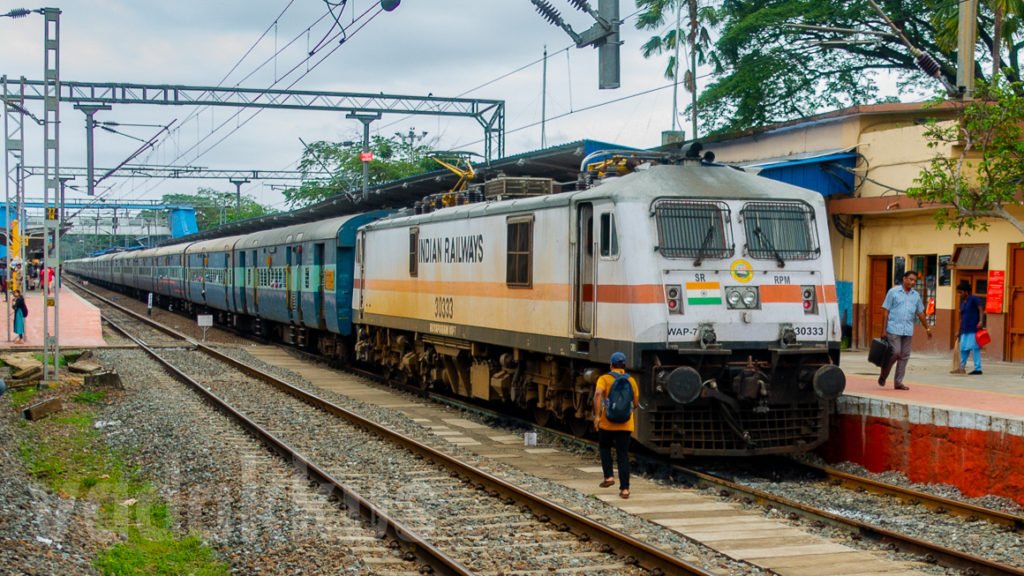
Don’t try making sense of the numbers, all you need to do to turn them into reality is to look out of a train window. Top running speeds of a train in Kerala rarely exceed that what you would do in your car on a common country road, not even a highway. The regular running speed of trains in Kerala most of the time will be just about the range of motorcycle speeds. This is not a joke. In most sectors in Kerala you can reach faster by road than by train, that too just in an old Ashok Leyland bus and not even in a car, and given the conditions of roads and traffic in Kerala (which are another level of hellscape altogether), that is really telling something. The extent to how irritating, agonising and so extremely frustrating the total, absolute, utter slowness of trains in Kerala are, has to be experienced to be believed. Here is a real-life story.
You board an express train. It starts moving, but even after some distance it does not pick up speed and continues to move very slowly, which you feel is unnatural for a train. You wait, expecting that it will speed up any minute, but it very annoyingly continues to move at its lethargic pace. After a distance it lazily shows signs of moving above 45-60 kph, but then you immediately feel the brakes as if an inadvertent mistake is being hasteningly corrected. As you continue on your slow journey past endless curves, you halt at almost all stations, no matter if it has a scheduled stoppage or not, at signals on the trackside and at other random spots every now and then. At stations, you languish for long, indefinite periods as signals refuse to change or even if they do, the train does not care and starts when it wants to. You sit there hating yourself as the train stupidly crawls around curves and over bridges, past embankments and in and out of loop lines and generally everywhere. As the train starts and stops and ambles along in fits, many hours late, struggling to make it to the next kilometre, your world moves in slow motion, as if time itself has slowed down, which then ceases to exist altogether and infinity becomes a tangible feeling. “Speed up, you idiots!” you want to shout, and you sometimes do. You fight your inner self which wants to get out and run along the tracks, which you feel ill get you to your destination quicker. You feel like pushing against the train to make it go faster. You cannot fathom how a train even can run so slow. You sit watching YouTube videos of sleek, shiny, super-fast engineering marvels smoothly zipping along tracks at 320 kph in neighbouring countries and even at 130, 150, 160 and 180 kph in more lucky and progressive parts of the country, sighing in wistful longing as you watch motorcycles and pigeons overtake your train trutting along the tracks. When you finally arrive, you realise that you just took four and a half hours to travel 160 kilometres. You actually were lucky that day because usually it takes five. (Your friends took three hours in a car).
Indian Railways Stretchable Timings
There are quite a lot of things that are often blamed for the slowness of trains in Kerala: overloaded tracks with bad or no maintenance, unscientific construction, antiquated signalling systems, curves, bridges, terrain, the scourge of stoppages etc., all bought about by years of under investment and utterly shortsighted policies. While all of this is true and quite self-explanatory, another reason is often overlooked. Many trains in Kerala run on timetables that were created or last changed in the 1980s, meaning that trains today are running according to conditions, factors and necessities of the 1980s. It is not that nobody has thought to revamp timetables to reflect present needs and conditions, but they purposefully haven’t done so as it would mean a great deal of investment to bring the railways of the state out of the 1980s and eventually having to run more and new trains which Southern Railway absolutely do not want to do. The timetable is the major tool used to slow down the trains in the state, making what is Mission Raftaar in the rest of the country Mission Sust, or Mission Slowdown in Kerala. Every once in a while, the timetable is tweaked to further extend the train’s required final arrival at the destination station by 15-30 minutes, thereby extending the running time and reducing the overall speeds of trains. The best part is that this is ostensibly to “improve on-time performance figures”! Don’t believe it?
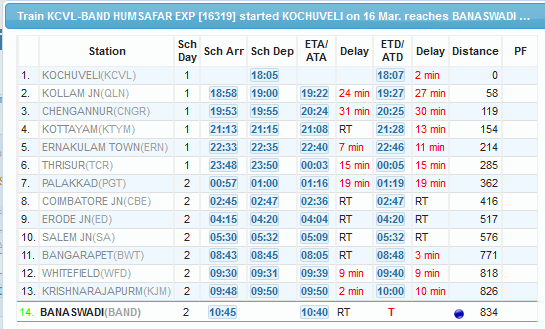
Some time ago, the honorable railway minister warned that officers would pay with their promotions if they failed to run trains on time. So what did the Southern Railway and Trivandrum division do? Did they pull up their socks and leave no ballast stone unturned to ensure trains ran on time? LOL no. They found another, easier “jugaad” solution to the problem. They simply added an additional 30 minutes to one hour of (slack) timing to the timetable of all trains! This made all late running trains arrive magically “on time”! For instance, a train that earlier had to arrive at 0930 now would have to arrive only at 1005! With this, they stopped having to put in any effort to make trains run on time! The official circular for this even states “Alteration of arrival timings to achieve target of 80% punctuality!” No, this is not a joke. This is like the education department reducing passing marks of the examination from 35% to 10% because the son of the education minister is too dumb to achieve even that.
Please click on the tweet and read the whole thread to know how frustrated passengers are with the railway admin in Kerala. This move explains what kind of commitment they have towards the passengers (hint: zero). The Prime Minister and the Railway Minister want to make trains run faster, but this is how self-serving officials derail any such plans. What about that extra half or one hour the passenger lost sitting in the train? Who cares! They only care about themselves. So, the result was that in one shot trains got slower again Average speeds of some “express” trains have dropped to as much as 29 kph now! But trains remained running late and Trivandrum division still remained in the bottom six among the divisions with the most delayed trains. What it did was increase slack timings to comically absurd levels. Here are some examples to showcase this.
- It was recently announced that the presently combined Amrita-Rajyarani Express, now leaving Trivandrum at 2230 in the night, will be split into two separate trains. The new Amrita Express will leave two hours early at 2030 to arrive at its destination at almost the same time as it does now! That is 11 hours 40 minutes to cover a measly 370 kilometers, at a mind-blowing speed of 31.6 kph! Can you imagine? In this time and age! That is the Bangalore – Coimbatore distance done by road in 6.5 hours without breaking a sweat! Are these people aware that trains in a neighbouring country up to the north can and do cover that distance in ONE HOUR and change? In some parts of our nation itself trains regularly do such distances in around four-five hours. Incredible. In between, they have given 4 hours for this train to cover the Thrissur-Palakkad section. Yes, for all of 50 kilometers. Buses do this stretch on a brand new four-laned highway (with a tunnel) in just over 45 minutes! And the irony gets worse.
- In a rather unbelievable twist of the laws of Physics, this same train also arrives much before time at many of its stations! Yes, it runs both late and before time at the same time! On most days, the 16344 Amrita Express arrives around 30 minutes before time at all its stations between Dindigul and Palakkad to lie idle for around two hours in all, wasting time and diesel. The train can easily be started from Madurai at 1730, saving passengers two entire hours! But no, for God knows why. Even with all their cronyism, would any private organisation even remotely tolerate such gross inefficiency?
- The 16381 Jayanti Janata Express sometimes arrives two hours before time at places like Wadi and half an hour at Ernakulam (and then it reaches Trivandrum one hour late).
- The 13357 Dhanbad-Alappuzha Express reaches Shoranur at 1450, from where it is allocated 5 hours 20 minutes to travel the remaining 164 km to Alappuzha (31 kph).
- 16315 is given 2 hours 15 min to cover the last 57 km from Kollam to Kochuveli “nonstop” at 26 kph!
- 12618 Mangala Lakshadweep “Superfast” Express now has a 1:30 hrs on the timetable to cover its last 70 km, which is ends up wasting by idling here and there.
- 16304 Vanchinad Express once was the fastest and most prestigious train on the Trivandrum – Ernakulam route. In the 1980s it covered the 220 km distance in 3 hours 50 minutes with two stops. Today it takes a heartbreaking 5 hours 40 minutes at 39 kph (with 17 stops) and is the slowest train on the route 🙁
- Even more recently, five trains were rerouted to bypass Shoranur Jn where they currently undergo a time-consuming loco reversal and instead will skip the station to go via the bypass. In an ideal world, this would mean savings of atleast 30 minutes of running time. However, there no is decrease in running times or change in timetables. Why?
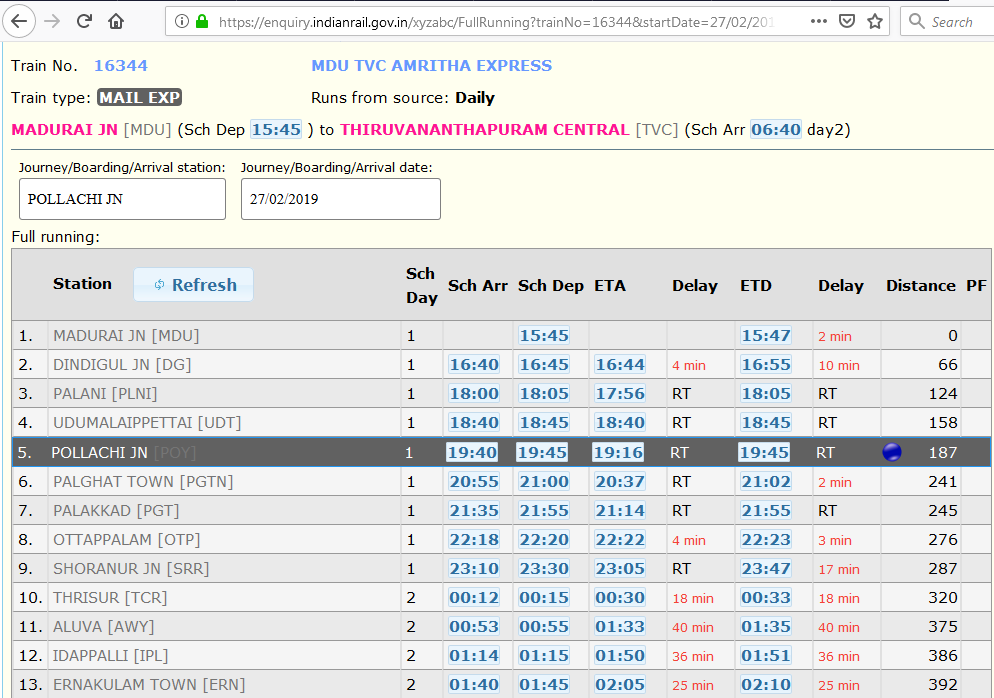
Examples like this abound in the state. All trains in the state run on inflated timetables that are stretched like elastic, and even then trains never run on time. If travel times keep increasing like this, and as most average speeds keep falling and approach 30 kph, what is the point in running trains? Will we pretty soon see overnight sleeper trains from Ernakulam to Palakkad? The operation departments of two divisions in Kerala, especially Trivandrum division are so absolutely adamant about not allowing conditions in the state to improve at any cost! Though zones across the country propose running trains to Kerala and the railways actually plan many projects in the state, Southern Railway and the two divisions keep blocking every such proposal giving some reason or the other, holding back the developmental efforts of the Indian government and all of the Indian Railways. Unbelievable. And they do it on purpose, because they don’t want to work, and there is no one to check or stop them. Isn’t anyone seeing this? Where are the people who are claiming that the state has made great strides? There is no point in hoping that trains in Kerala will ever get faster.
A word on Stoppages: Kerala is notorious for even ultra-long distance express trains stopping at every small station on the way. People from other places and states gawk in disbelief at how the Kerala Express halts every 15 km in Kerala, thinking it is some kind of conspiracy. There isn’t, it is only sheer necessity. The reason even long-distance trains stop at every other station in the Kerala is because they all turn into commuter trains once they enter the state, filled with short-distance and commuter passengers. The fact remains that you stop any train at any station in Kerala, there will be people to patronise it. In the hundreds. This is why the state needs a full-length rapid transit railway system to best serve its highly evenly distributed, urbanised population and not random national integration weeklies.
Controlling Operations
In addition to speed, the peak misery is again accorded to commuters by the railway operations of the two divisions is through their controlling operations. The way trains are given priority or order of precedence on the tracks most of the time seems so absolutely senseless that it looks like they are out to purposefully harass passengers. It might mostly seem arbitrary, but the general rule in Kerala says that passenger (ordinary) trains, no matter if they are full or empty, are almost always given precedence over mostly everything else including everything from important commuter expresses like Venad and premium Superfast trains like the Jan Shatabdi. The latter is an exceptionally sad case, made to wait every day in both directions for an empty passenger train to cross it. It is also made to crawl behind seasonal specials and empty cross-country crawlers. That frustrating monologue about a crawling train? That was an actual experience of mine, when my all-AC “Superfast” express was stuck behind a passenger train for almost all of its 160-km run. It does not matter that the passenger stops at every station, and the is only at a number of limited stations and charges 10 times that of the passenger. But no, no overtakes, ah-ah. Unless you are a freight train, of course, that will be allowed to go ahead of even the passenger! I once missed a connection at Shoranur because the 12202 Garib Rath was held up at SRR home (outer) to let a freight train from the Palakkad side through the station. Even the Rajdhani is usually not spared. For exasperation sake, here is the rough order of priority accorded to trains by the Trivandrum division.
- Empty passenger trains
- Other passenger trains
- Freight trains
- Non-daily express trains of other zones
- Daily express trains of other zones
- Seasonal specials
- Express trains of Southern Railway but not of Trivandrum division
- Non-daily express trains of Trivandrum division
- Daily long distance express trains of Trivandrum division
- Executive/InterCity/Parasuram/Ernad/Venad
- MEMU trains of Trivandrum division
- 12075/12076 JanShatabdi Express
- 16303/16304 Vanchinad Express
Jokes apart, it is a myth that the way trains are controlled or allowed precedence on tracks is to run them on time and to improve customer satisfaction or operational efficiency. Rather, the aim is only to meet bureaucratic convenience. For instance, services are often intentionally delayed to make them run in empty slots (timetables) of other trains, crossings and overtakes are done only at nominated stations and not to save time, starters are often not on given on time, extending one minute stoppages to three or five and trains are not allowed ahead even after the train ahead has cleared the block. Goods trains are strategically stationed on the mainline making passenger-carrying trains to crawl around loop lines. It does not matter that all this will only further delay trains and increasing the misery of passengers. There seems to be no will to make trains run on time from the officials’ side as it is easier for them to just follow the playbook rather than to make complicated decisions. Instead of slightly delaying one train to allow everything to run more or less on time, they instead manage to run all trains late. While trains all over the world aim to reduce travel times and to allow comfortable and fast travel with the least hassle, in Kerala they are run only to fulfill bureaucratic obligations. Everything else does not figure. And to be honest, all this is not really limited to Kerala.
The speed of trains in the state are limited by infrastructural constraints and improving track and path conditions are the key to improving speeds, there is no doubt in that. But as an immediate measure rationalising timetables and operations will help. The basic problem here is having no value for the time and money of passengers as they are viewed as voiceless herds who are to shut up and endure whatever is thrown at them. The Southern Railway and Railway Board themselves have identified TVC’s administration and operations the culprits behind late running of trains by their unscientific and inefficient way of handling train operations and scheduling. But like all reports, that also turned out to be of no avail as things only keep deteriorating. There seems to be absolutely no hope of anything improving anywhere in the near future as no one is interested in that, with no projects aimed at this being even discussed anywhere. The speed and operating conditions will remain the same for atleast a decade. Well, with the people of Kerala claiming it to be the “most developed”, the railways probably thinks that funds better be diverted to places that need them more. You can’t blame them. Just like the Malayalee, the only way to make the train run faster and get ahead is for it to leave the state.
But still, the infrastructure on how the track is built still plays a major role in the lack of speeds of trains in the state. We take a look at that in the next chapter.
P.S. Maybe in passenger trains are accorded greater priority than express trains in line with the socialist principles of the state. “The smallest member of the society should get better preference than everyone else.” So why not? Another theory is that slow speeds give tourists a better chance to drink in the natural beauty of Kerala with much better fervour.
Other Chapters in the State of the Railways in Kerala Series
- The Tales of the Travails of Kerala’s Railways
- Kerala Has the Worst Railway Infrastructure in India
- Lack of Funds Derailed Railway Development in Kerala
- Discrimination Derailed Railway Development in Kerala
- The State of Train Running Infrastructure in Kerala
- The State of New Railway Lines in Kerala
- The State of Track Infrastructure in Kerala
- The State of Railway Terminals in Kerala

